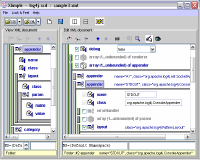|
XAmple XML Editor
 XAmple XML Editor project introduces a java Swing based XML editor that
analyzes a given schema and then generates a document-specific graphical
user interface. Unlike other XML editors, the XAmple XML editor GUI exposes
not just a tree representation of the XML document but rather a logical
combination of the XML document and respective XML Schema. The user interface
of the XML editor is highly logical and intuitively comprehensible. To
be able to prepare valid XML documents of significant complexity, a user
is not required to be familiar with XML and XML Schema languages and to
have any a-priori knowledge about the documents structural requirements.
XAmple XML Editor project introduces a java Swing based XML editor that
analyzes a given schema and then generates a document-specific graphical
user interface. Unlike other XML editors, the XAmple XML editor GUI exposes
not just a tree representation of the XML document but rather a logical
combination of the XML document and respective XML Schema. The user interface
of the XML editor is highly logical and intuitively comprehensible. To
be able to prepare valid XML documents of significant complexity, a user
is not required to be familiar with XML and XML Schema languages and to
have any a-priori knowledge about the documents structural requirements.
The project currently includes a simple set of XML viewer/editor Swing
components (FXBasicView, FXView and FXDoubleView), XML editor data model
object FXDocumentModelImpl, sample XML Editor application XAmple and XML
editor demo applet FXApplet. FXBasicView Swing component provides all
the basic XML viewer/editor functionality. FXView extends FXBasicView
with a simple tool-bar; FXDoubleView exposes two FXView components,
one in Editor mode and another one in Viewer mode.
| Software Information |
System Requirements |
| Version: |
2.2 |
- Windows 98/ME/NT4/2000/XP/Vista
- 256 MB RAM
- Pentium II CPU
|
| File Size: |
1.90 MB |
| Screenshot : |
View Screenshot |
| Rating : |  |
Key Features of XAmple XML Editor:
- Additional labeling of the elements/groups with information, taken from their descendants
– in Divisions, Log4j, Jnlp, Ejb-jar_1_1, Xmldbms.
- Multiple namespaces support – in Divisions. Divisions.xsd schema document uses Types.xsd
schema document, which defines its own namespace.
- Custom field editors, declared within "appinfo" elements of the schema document –
in Divisions, TagLibrary, Xmldbms. All the field editing check-boxes, editable combo-boxes
and text area dialogs in these examples are custom editors.
- ID-IDREF referential integrity control – in Log4j. The application provides drop-down
lists of available ID values for editing of the IDREF values.
- Messages for selected nodes - Divisions, TagLibrary. In “Divisions” example messages
are defined for the "Division" elements (in both element and type definitions) and
{Supervisor or Employee}/ChoiceGroup/SequenceGroup #2/ContractStartDate-ContractEndDate elements.
In the “TagLibrary” example messages saying "Fully qualified class name" are defined
for "validator-class", "listener-class", "tag-class" and "tei-class" fields. You can easily
insert your own messages into “documentation” schema elements for any element, attribute and type definitions.
- Regular expressions control during typing - Divisions, TagLibrary. In the “Divisions” example
try to edit {Superviser or Employee}/EmployeeInfo/SSN fields. In the “TagLibrary” example try to
edit any "*-class" field.
- Nested grouping - Divisions (choice groups within "Supervisor" and "Employee" elements
contain sequence groups). Since these choice groups contain other groups, they are represented
with radio-groups. All the other choice groups in all the examples contain elements and therefore
they are represented with drop-down lists.
- Substitution group - Division ({Supervisor or Employee}/array of < File > elements).
- Schema "all" Group - Divisions. It is labeled "Reorderable Group" and resides within {Supervisor or Employee}/EmployeeInfo/EContact elements.
- elementFormDefault="unqualified" - Log4j, elementFormDefault="qualified" – all other examples.
- Search for invalid nodes - Divisions - Divisions_BAD.xml. This xml file contains 3 errors. Try to load it and click "Find invalid node" button. After each button click the editor shows next invalid node found.
- Wild-xsd-groups example demonstrates a new ability of the XAmple XML editor v2.2 to resolve correctly non-trivial combinatorial problems of reconstruction of hierarchies of xsd:sequence and xsd:choice groups for given sequences of child xml elements.
RELATED SOFTWARE DOWNLOADS FOR XAMPLE XML EDITOR
|
|







 XAmple XML Editor project introduces a java Swing based XML editor that
analyzes a given schema and then generates a document-specific graphical
user interface. Unlike other XML editors, the XAmple XML editor GUI exposes
not just a tree representation of the XML document but rather a logical
combination of the XML document and respective XML Schema. The user interface
of the XML editor is highly logical and intuitively comprehensible. To
be able to prepare valid XML documents of significant complexity, a user
is not required to be familiar with XML and XML Schema languages and to
have any a-priori knowledge about the documents structural requirements.
XAmple XML Editor project introduces a java Swing based XML editor that
analyzes a given schema and then generates a document-specific graphical
user interface. Unlike other XML editors, the XAmple XML editor GUI exposes
not just a tree representation of the XML document but rather a logical
combination of the XML document and respective XML Schema. The user interface
of the XML editor is highly logical and intuitively comprehensible. To
be able to prepare valid XML documents of significant complexity, a user
is not required to be familiar with XML and XML Schema languages and to
have any a-priori knowledge about the documents structural requirements. BestShareware.net. All rights reserved.
BestShareware.net. All rights reserved.

